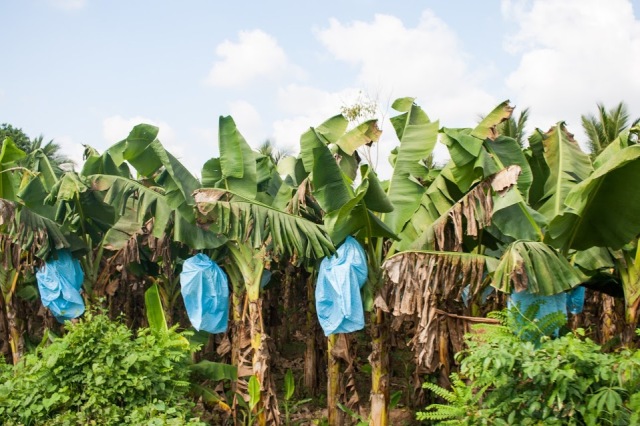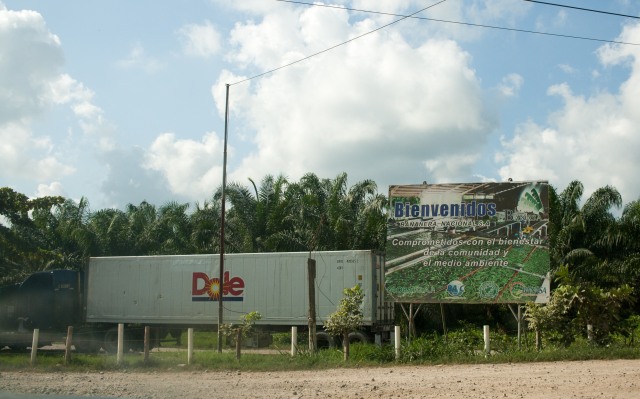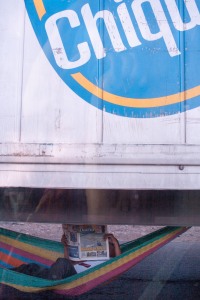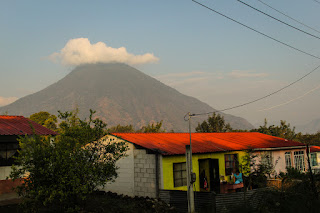 |
| Foto tomada por: Anna Vogt |
Por Nancy Sabas
El conflicto de las Empresas de Banano y Palma de aceite en el municipio de la Blanca, Guatemala.
“Dígame usted que es periodista y yo que no soy estudiado:
¿Secar las lagunas se llama desarrollo?
¿Fumigar las comunidades se llama desarrollo?
Yo que no soy estudiado, sé que eso no es desarrollo
Yo que soy analfabeta, sé que eso se llama violación.”
– Campesino y vecino de la comunidad de la Blanca.
Hace un par de meses, viajé al al municipio de La Blanca para entrevistarme con los vecinos y líderes comunitarios de las Comunidades de la Costa Sur en Defensa del Territorio, junto con el Co-Representante de País del Comité Central Menonita y la Analista de Incidencia Política para Latinoamérica y El Caribe de la misma organización, con el fin de aprender más sobre la problemática de los monocultivos y su agroindustria en Guatemala.
Reconocí la comunidad de manera inmediata, tras haberla visto antes en el documental producido por la Pastoral de la Tierra -Diócesis de San Marcos- “Ocos Despierta”, que usamos con los grupos de aprendizaje cuando hablamos sobre los monocultivos. Del documental, siempre me llamó la atención una escena en la que un hombre aparecía en medio del río Zanjón Pacayá, denunciando la muerte de los peces y atribuyendo esta mortandad a la contaminación por desechos tóxicos de las empresas bananeras y palmeras en el área. Esta escena me pareció peculiar por el lenguaje que el señor usaba, que no sólo me transmitió su preocupación por la subsistencia de su comunidad, sino también su amor y angustia por un río que él entiende que está vivo, pero al que están matando. La conexión de este hombre con la madre naturaleza que percibí en esa escena me hizo despreciar un poco la urbanidad en la que crecí y que me enseñó a verla como un mero recurso.
 |
| Foto tomada por: Anna Vogt |
Desafortunadamente, ese mal aprendizaje de entender a la naturaleza como una materia que puede ser abusada y explotada es herencia de una lógica capitalista. Bajo esta misma lógica, la agroindustria de monocultivos en municipios como La Blanca, Guatemala, van destruyendo los ecosistemas bajo la insignia del desarrollo.
La industria de los monocultivos, es una industria que va creciendo a pasos agigantados. De acuerdo a datos de la Encuesta Nacional Agropecuaria del 2014, el segundo cultivo del tipo permanente con mayor importancia, en cuanto a su volumen de producción, fue la palma africana, cuyo registro en ENA 2014 aumentó en un 118%, en relación a ENA 2013. En cuanto a la superficie cultivada de palma africana, esta tuvo un aumento del 33% respecto a la ENA del 2013.[i] Los datos oficiales publicados por el ENA en años anteriores han mostrado inconsistencias con respecto a datos proveídos por la Gremial de Palmicultores de Guatemala (GREMPALMA), y otras investigaciones, quienes estiman que la expansión del cultivo ha sido aún mayor. [ii]
Sin duda este crecimiento industrial es también un reflejo de un incremento en el flujo de dinero. Estas megaempresas ofrecen empleos de mano de obra no calificada y financian proyectos de infraestructura locales. ¿Se traduce esto en una mejoría en la calidad de vida de los vecinos de la comunidad?
 |
| Foto tomada por: Anna Vogt |
“Antes habían tres cosechas y ahora solo hay una”, Nos cuenta Eduardo Juárez, Presidente de la organización Comunidades de la Costa Sur en Defensa del Desarrollo de las 12 comunidades en la Costa Sur apoyadas por nuestro socio local, la Pastoral de la Tierra, “Hay niños con granos en la piel y problemas respiratorios -agregó otro compañero- “Nuestro rio Pacayá nos daba peces para comida y para vender. Todo el mundo venía a pescar, desde Coatepeque y La Blanca. En el invierno el rio se regeneraba por las lagunas pequeñas. La pampa del tigre tenía lagartos, tortugas y diferentes especies de animales. El cerro el montículo se conocía como ¨El encanto¨ porque se oían los cantos de los gallos y los animales. Ahora solo vive la palma africana. Es lamentable que pasen 10 años y nadie haga nada. La pampa aun aparece en el mapa pero la verdad ya no existe. Esto nos ha afectado el derecho a la vida y a la alimentación”.
La ambientalista Hindú, Vandana Shiva en su ensayo “Economía revisitada: ¿Será el verde el color del dinero o de la vida?” planteaba: “La naturaleza ha sido sometida al mercado como una mera proveedora de materia prima industrial y vertedero de residuos y la contaminación. Se afirma falsamente que la explotación de la tierra crea valor y crecimiento económico, y que consecuentemente se mejora el bienestar humano. El bienestar humano es el argumento que se usa para separar a los humanos de la tierra y justificar la explotación sin límites, aunque no toda la humanidad se beneficie de eso. De hecho la mayoría pierde. Poner a los seres humanos en contra la naturaleza no es meramente antropocéntrico, sino empresa-céntrico.”.[iii]
Guatemala ha fallado en establecer instituciones apropiadas que regulen el uso del agua. Esta falla representa un grave problema de transparencia, especialmente con las compañías mineras, hidroeléctricas y de agroindustria, quienes usan una amenazante cantidad de agua para sus operaciones. Las empresas presentes en el municipio de La Blanca son Grupo HAME y BANASA. La compañía DOLE y Chiquita banana son las principales comercializadoras de su producción de banano. De acuerdo con testimonios locales, La empresa BANASA y Grupo HAME tuvieron un conflicto legal sobre el agua proveniente del rio el Ocosito para efectuar sus operaciones, dejando a la comunidad en medio de la problemática.
Según estimaciones de los vecinos de La Blanca e investigaciones independientes, se dice que las compañías usan alrededor de 40,000 galones de agua por minuto. En un documento presentado por las Comunidades de La Costa Sur en Defensa del Territorio en la IV audiencia pública del Tribunal Latinoamericano del Agua expresan:
“La Bananera Nacional S.A. (BANASA) ha construido un sistema de irrigación y drenaje que conecta el río Ocosito con el río Pacaya, cubre toda su plantación y tiene como propósito controlar las condiciones de humedad en la tierra. Ello provoca dos tipos de afectaciones a las comunidades campesinas: (1) en época de verano/sequía los campesinos sufren insuficiencia de agua debido a su extracción de agua; río arriba de los afluentes con caudales muy reducidos; y (2) en época de invierno/lluvia la población está afectada por el aumento grave de la inundación de sus cultivos y casas de habitación. Además, el desfogue de agua desde las fincas de la bananera hacia el río Pacayá ha causado contaminación industrial y la presencia de peces muertos en el mismo. (…)Se otorgan múltiples autorizaciones de extracción de los ríos, generando conflicto entre las empresas y entre estas y las comunidades, con la consecuente reducción de los caudales que necesitan las comunidades. El Estado ha incumplido en realizar estudios de ordenamiento hídrico detallados”. [iv]
El año pasado la lucha de las 12 comunidades de la Costa Sur cumplió 10 años. 10 años en demanda de compensaciones por compensaciones por daños y perjuicios a las comunidades, reparaciones de las pampas, el cierre de los quíneles y de los pozos, el establecimiento de una planta de tratamiento de agua, por la conservación de los ríos y la abolición de los monocultivos. 10 años cargados de dignidad y resistencia a un modelo que no venera la vida.
“Enfrentarse a ellos es cómo enfrentarse a un monstruo” relataba uno de los miembros de las 12 comunidades en la Costa Sur. Sin embargo, de alguna forma, el monstruo ha sido incapaz de callar sus voces que claman por la justicia y el Buen vivir.
Para ver el Documental de OCOS:
[i] Republica de Guatemala: Encuesta Nacional Agropecuaria 2014. http://www.ine.gob.gt/sistema/uploads/2015/10/16/iQH6CPCSZUC1uOPe8fRZPen2qvS5DWsO.pdf
[ii] Memorial de denuncia ante la Comisión Interamericana de Derechos Humanos (2015) Washington.
Mikkelsen, Vagn. (2013). Guatemala: Comercio Exterior, Productividad Agrícola y Seguridad Alimentaria Pg. 10
[iii] Vandana Shiva (2014) Economy Revisited. Will Green be the Colour of Money or Life? Global Research http://www.globalresearch.ca/economy-revisited-will-green-be-the-colour-of-money-or-life/5393406
[iv] Resolucion Banano y su impacto en las fuentes de Agua Guatemala (2015) Tribunal Latinoamericano del Agua http://tragua.com/wp-content/uploads/2015/10/Resolutivos_2015_Guatemala_TLA_BANANO.pdf





